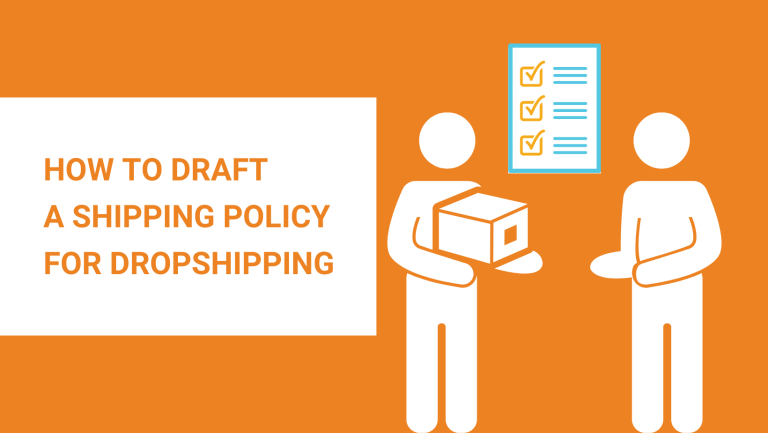Shipping is arguably the most significant part of dropshipping. It is the penultimate step that ensures that customers receive the products they ordered from your store.
Subsequently, it is imperative that you have a clear shipping policy for dropshipping that outlines what customers can expect at the order fulfillment stage.
In this discussion, we answer key questions regarding shipping policies and how to come up with one that fits the requirements to start your dropshipping business.
Would you like to learn more? Sit back and read on.
Key Takeaways
- A shipping policy is essential for setting clear expectations and building customer trust.
- Your policy should cover shipping methods, costs, and delivery timeframes.
- Displaying your shipping policy prominently can improve the customer experience and reduce inquiries.
What Is a Shipping Policy for Dropshipping?

A shipping policy for dropshipping is a document that explains to customers how you handle all shipping issues in your dropshipping store.
It comprises details such as:
- How soon ordered products are processed and shipped
- The methods (such as couriers or mailing services) used to ship orders
- The costs of shipping
Notably, dropshipping fulfillment is handled by your dropshipping suppliers. As such, the shipping policies you state on your store’s website should, ideally, match the shipping policies of your suppliers.
Why Do You Need a Shipping Policy?
A well-crafted shipping policy is essential for your dropshipping business. It builds trust with your customers and helps set clear expectations about delivery times and costs.
Reducing cart abandonment is a key benefit of a good shipping policy. When customers know upfront what to expect, they’re less likely to abandon their carts due to surprise shipping fees or unclear delivery timelines.
Your shipping policy also helps minimize customer service queries. By providing clear information about shipping methods, costs, and timelines, you can reduce the number of inquiries your team needs to handle.
Here are some key reasons why you need a shipping policy:
- Improves transparency
- Sets customer expectations
- Reduces order cancellations
- Enhances overall customer experience
A clear policy can lead to increased customer satisfaction. When you provide detailed information about shipping methods and processing times, customers feel more informed and in control of their purchase.
Did you know that 66% of online shoppers consider shipping costs before making a purchase? By clearly outlining your shipping fees and options, you help customers make informed decisions.
Remember, your shipping policy is often the first point of contact between you and potential customers. Make it count by being clear, concise, and customer-friendly.
What to Include in Your Shipping Policy

A comprehensive shipping policy is crucial for dropshipping success. It sets clear expectations for customers and helps prevent misunderstandings. Let’s explore the key elements you need to include in your policy.
Shipping Destinations
Clearly list all countries you ship to in your policy. This transparency helps customers quickly determine if you serve their location. Consider creating a table with two columns: “Countries We Ship To” and “Countries We Don’t Ship To”.
Be specific about any regional restrictions within countries. For example, you might ship to the continental United States but exclude Hawaii and Alaska.
Explain why you don’t ship to certain areas. This could be due to high shipping costs, customs regulations, or logistical challenges. Providing reasons can help customers understand your decisions.
If you plan to expand your shipping destinations in the future, mention this. It shows potential for growth and can keep customers interested in future possibilities.
Shipping Methods And Carriers
Offer a variety of shipping options to cater to different customer needs. Standard, expedited, and express shipping are common choices. Explain each option clearly, including estimated delivery times and cost differences.
List the carriers you work with, such as DHL, FedEx, or USPS. Each carrier has strengths and weaknesses. For example, DHL might be faster for international shipments, while USPS could be more cost-effective for domestic deliveries.
Create a simple comparison table:
| Carrier | Domestic Speed | International Speed | Cost |
| DHL | 2-3 days | 3-7 days | $$$ |
| FedEx | 1-2 days | 4-8 days | $$$$ |
| USPS | 3-5 days | 7-14 days | $$ |
Explain how you choose carriers for different orders. This might depend on package size, destination, or customer preference. Transparency about your selection process can build trust with customers.
Shipping Times

Provide clear estimates for shipping times based on destination and chosen method. Be realistic to avoid disappointment. Consider creating a map or table showing estimated delivery times for different regions.
Explain that shipping times are estimates and can vary due to factors like customs processing or weather conditions. This sets appropriate expectations and reduces customer frustration if delays occur.
Include information about order processing time. For example: “Orders are typically processed within 1-2 business days before shipping.” This helps customers understand the full timeline from order placement to delivery.
Mention any cut-off times for same-day processing. For instance: “Orders placed before 2 PM EST on business days will be processed the same day.”
Shipping Costs
Clearly outline your shipping cost structure. This could be free shipping, flat-rate shipping, or calculated rates based on weight and destination. Explain each option to help customers understand what to expect.
If you offer free shipping, specify any conditions. For example: “Free shipping on all orders over $50 within the continental US.”
For calculated rates, provide examples: “Shipping to New York typically costs $5-$10 for standard delivery, while shipping to California may range from $8-$15.”
Discuss any surcharges for oversized or heavy items. Be transparent about these additional costs to prevent surprises at checkout.
Consider offering shipping insurance as an optional add-on. Explain the benefits and cost of this service.
Tracking Information
Explain how and when customers will receive tracking information. For example: “You’ll receive a tracking number via email within 24 hours of your order being shipped.”
Provide instructions on how to use the tracking number. Include links to carrier websites where customers can enter their tracking information.
Mention if you offer any additional tracking services, such as SMS updates or integration with shopping apps. This can enhance the customer experience and reduce support inquiries.
Explain any limitations of tracking. For instance, some international shipments may not have detailed tracking once they leave the origin country.
Handling Delays and Issues
Outline your process for handling shipping delays. Explain how you’ll communicate with customers if their order is delayed. For example: “We’ll send you an email notification if your order is delayed by more than 2 business days.”
Provide a template for delay communications:
“Dear [Customer Name],
We regret to inform you that your order [Order Number] has been delayed due to [Reason].
We expect your package to ship by [New Date]. As compensation for this inconvenience, we’re offering you a 10% discount on your next order.
We apologize for any inconvenience and appreciate your patience.”
Discuss potential causes of delays, such as supplier issues or carrier problems. This helps customers understand that some factors are beyond your control.
Explain any compensation or resolution you offer for significant delays. This could include discounts on future orders or expedited shipping at no extra cost.
Lost or Damaged Packages

Clearly state your policy for lost or damaged packages. Explain who is responsible (you, the carrier, or the customer) in different scenarios. For example: “We are responsible for packages until they are marked as delivered by the carrier.”
Outline the process for filing a claim:
- Contact customer service within X days of the expected delivery date
- Provide order number and any relevant photos or documentation
- Allow X business days for investigation
Explain how you handle refunds or reshipments for lost or damaged items. For instance: “We will reship your order at no additional cost if it’s lost in transit. For damaged items, we may request photos before issuing a refund or replacement.”
Provide a timeframe for resolving these issues. This sets clear expectations for customers during a potentially stressful situation.
Customs and Import Duties
Explain that international orders may be subject to customs fees and import duties. Clarify who is responsible for these charges – typically the customer.
Provide an example calculation of potential customs fees for a popular destination country. This helps customers understand the potential additional costs.
Mention that customs processes can delay shipments. Explain that these delays are beyond your control and may affect estimated delivery times.
Provide resources for customers to estimate their potential customs charges. These could be links to official customs websites or duty calculators.
Explain how customs documentation is handled. For example: “We accurately declare all items and values on customs forms. We cannot mark items as ‘gifts’ to avoid customs fees.”
Order Changes and Cancellations
Clearly state your policy for order modifications and cancellations. Include any time limits or conditions. For example: “Orders can be modified or cancelled within 2 hours of placement. After this period, orders cannot be altered or cancelled due to processing. Please contact customer support immediately for any urgent changes.”
Explain the steps customers should take if they need to request a change, such as emailing support or using a specific form on your website.
How to Write a Good Shipping Policy for Dropshipping
Creating an effective shipping policy is crucial for your dropshipping business. A well-crafted policy sets clear expectations, builds trust, and helps prevent misunderstandings with your customers.
1. Use Clear and Concise Language
Your shipping policy should be easy to understand. Avoid using technical jargon or complex terms that might confuse your customers. Instead, opt for simple, straightforward language.
Break down complex concepts into bite-sized pieces. For example, instead of saying “transit time varies based on destination,” you could say “delivery times depend on where you live.”
Use bullet points or short paragraphs to make information easy to scan. This helps customers quickly find the information they need.
Create a clear shipping policy that explains your processes in simple terms. This approach can reduce customer inquiries and improve satisfaction.
2. Be Transparent about Shipping Costs

Transparency is key when it comes to shipping costs. Clearly state all fees associated with shipping, including any potential customs charges for international orders.
Consider creating a shipping cost table that shows different rates based on order value or destination. This visual aid can help customers quickly understand what they’ll pay for shipping.
If you offer free shipping above a certain order value, make this clear. For example: “Free shipping on all orders over $50!”
Be upfront about any additional fees. If you charge extra for expedited shipping or oversized items, spell this out clearly in your policy.
3. Set Realistic Delivery Expectations
Accurate delivery estimates are crucial for customer satisfaction. Provide a range of days rather than a specific date to account for potential delays.
For example: “Orders typically arrive within 5-7 business days for domestic shipments.”
Explain how you calculate shipping times. You might say: “Shipping time = processing time (1-2 days) + transit time (varies by location).”
If you dropship from multiple locations, consider creating a map or table showing estimated delivery times for different regions.
Be clear about when the clock starts ticking. State whether shipping times begin from the order date or the ship date.
4. Address Potential Shipping Issues
Proactively addressing common shipping problems can save you time and headaches later. Outline your process for handling lost or damaged packages.
Explain what customers should do if their package doesn’t arrive on time. For instance: “If your order hasn’t arrived within 10 business days, please contact our support team.”
Describe how you handle address errors. You might say: “We’re not responsible for packages sent to incorrect addresses provided by customers. Please double-check your shipping information before placing an order.”
Consider offering shipping insurance as an option for high-value items. Explain the benefits and any associated costs.
5. Include Information on International Shipping

If you ship internationally, dedicate a section of your policy to this topic. Explain any restrictions on international shipping, such as countries you don’t ship to.
Clearly state that customers are responsible for customs fees, taxes, and duties. You might say: “International customers may be subject to import fees. These are not included in our shipping charges.”
Provide estimated delivery times for international orders. Be sure to mention that these can vary significantly due to customs processing.
Explain any differences in your return policy for international orders. For example, you might not cover return shipping costs for international returns.
6. Highlight Your Return and Refund Policy
Your shipping policy should include or link to your return and refund policy. Clearly state your return window, such as “30 days from the delivery date.”
Explain who covers return shipping costs. You might offer free returns or ask customers to pay for return shipping.
Outline any conditions for returns, such as items being in original packaging or unworn condition.
Describe your refund process. For example: “Refunds are processed within 5-7 business days after we receive the returned item.”
7. Update Regularly
Keep your shipping policy up-to-date. Set a reminder to review it quarterly or whenever you make changes to your shipping processes.
If you change shipping carriers or methods, update your policy accordingly. This ensures customers have accurate information about their delivery options.
When you update your policy, consider notifying customers via email or a website banner. This shows transparency and helps prevent confusion.
Keep track of common customer questions about shipping. Use these to improve and clarify your policy over time.
8. Use a Friendly and Professional Tone
Strike a balance between friendliness and professionalism in your shipping policy. Use “you” and “we” to create a conversational tone.
For example, instead of “Shipments will be processed within 24 hours,” try “We’ll process your order within 24 hours.”
Show empathy for potential customer concerns. You might say: “We understand how important it is to receive your order quickly. That’s why we aim to ship all orders within one business day.”
Use positive language. Instead of focusing on restrictions, highlight the benefits of your shipping policy.
9. Provide Contact Information for Support

Make it easy for customers to reach you with shipping-related questions. Include multiple contact options such as email, phone, and live chat if available.
Clearly state your customer service hours. For example: “Our support team is available Monday to Friday, 9 AM to 5 PM EST.”
Consider creating a FAQ section specifically for shipping-related questions. This can reduce the number of inquiries you receive and provide quick answers for customers.
Offer clear support options to help customers with their shipping concerns. This approach can improve customer satisfaction and reduce frustration.
Where to Display Your Shipping Policy

Placing your shipping policy in easily accessible locations on your website is crucial for customer satisfaction and transparency. Strategic placement ensures shoppers can quickly find important shipping information before making a purchase decision.
The footer menu is an ideal location for your shipping policy link. It’s consistently visible across all pages, making it easy for customers to find. 85% of online shoppers check shipping information before completing a purchase.
Include a clear “Shipping Policy” link in your footer navigation. Use descriptive anchor text like “Free Shipping on Orders Over $50” to encourage clicks. Consider grouping it with other policy links such as Returns and Privacy for better organization.
Website banners are perfect for highlighting temporary shipping promotions or policy updates. They grab attention immediately when visitors land on your site. 53% of consumers are more likely to purchase when free shipping is offered.
Create an eye-catching banner announcing “Free Shipping Week” or “New International Shipping Options Available”. Use contrasting colors and concise text. Link the banner to your full shipping policy page for details.
The FAQ Section
Integrating key shipping policy details into your FAQ section provides quick answers to common customer questions.
This reduces support inquiries and improves the shopping experience. 64% of customers expect to receive real-time assistance with their online purchases.
Include FAQs like:
- “How long does shipping take?”
- “Do you offer international shipping?”
- “What are your shipping rates?”
Provide brief answers with links to the full shipping policy for more information.
Product Pages

Adding shipping information directly on product pages informs customers before they reach checkout. This transparency can increase conversions and reduce cart abandonment. 60% of customers abandon their carts due to unexpected shipping costs.
Include a “Shipping” tab or section on each product page. Display estimated delivery times and shipping costs based on the customer’s location. Use a shipping calculator tool to provide accurate quotes.
Highlight free shipping thresholds to encourage larger purchases: “Free shipping when you spend $75 or more!”
By strategically placing your shipping policy across these key areas, you’ll create a more informed and satisfied customer base for your dropshipping store.
FAQs about Shipping Policy for Dropshipping
Creating an effective shipping policy for your dropshipping business involves addressing key concerns and staying up-to-date with industry changes. Let’s explore some common questions to help you craft a comprehensive policy.
How Often Should I Update My Shipping Policy?
You should review and update your shipping policy at least every 3-6 months. Changes in shipping costs, carrier options, or your business model may necessitate updates.
For example, if you start offering free shipping on orders over $85, you’ll need to reflect this in your policy.
Keep an eye on carrier rate changes, which typically occur annually. These adjustments can impact your shipping costs and, consequently, your policy.
Do I Need a Separate Policy for Domestic and International Shipping?
Yes, it’s beneficial to have separate policies for domestic and international shipping.
Domestic shipping is often simpler, with fewer variables and shorter delivery times. International shipping involves additional factors like customs fees and longer transit times.
You can address these differences by creating distinct sections within your policy. This approach helps customers quickly find relevant information based on their location.
What Is the Shipping Policy on Shopify?
Shopify provides customizable shipping policy tools that you can tailor to your dropshipping business. You can easily set up shipping rates, delivery times, and specific conditions for different products or customer locations.
To create an effective Shopify shipping policy:
- Use clear language to explain your shipping processes.
- Include estimated delivery times for various shipping methods.
- Specify any restrictions or additional fees for certain products or locations.
Remember to integrate your policy seamlessly with your store’s design for a professional appearance.
Wrapping Up: Best Practices for a Shipping Policy for Dropshipping
Creating a shipping policy for your dropshipping store is crucial for success. It builds trust with customers and sets clear expectations. Remember to include key elements like shipping methods, costs, and delivery times.
Be transparent about potential delays and international shipping considerations. Customize your policy to fit your specific business needs and products.
Keep your policy up-to-date as your business grows and shipping practices change. Clear communication reduces customer inquiries and improves satisfaction.
Don’t forget to address returns and refunds in your policy. This helps manage customer expectations and streamlines the post-purchase process.
Ready to take your dropshipping business to the next level? Request a sourcing quote from us at NicheDropshipping to find reliable suppliers and optimize your product offerings.
With a solid shipping policy and the right partners, you’ll be well-equipped to thrive in the competitive world of e-commerce.

